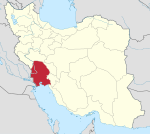Susangerd
Susangerd
| |
|---|---|
City | |
| Coordinates: 31°33′25″N 48°11′22″E / 31.55694°N 48.18944°E[1] | |
| Country | Iran |
| Province | Khuzestan |
| County | Dasht-e Azadegan |
| District | Central |
| Population (2016)[2] | |
• Total | 51,431 |
| Time zone | UTC+3:30 (IRST) |
Susangerd (Persian: سوسنگرد)[a] is a city in the Central District of Dasht-e Azadegan County, Khuzestan province, Iran, serving as capital of both the county and the district.[4] The vast majority of its inhabitants are Khuzestani Arab people. Susangerd is considered among the famous cities of Iran due to the Iran-Iraq war and the city's liberation from the siege of Iraqi forces.[5]
History
[edit]In the past, the city of Susangerd was a village called Khafajieh and the area around it was called Dasht-e-Mishan.[6] Later, during the reign of Reza Shah, this village was changed to the name of the city of Susangerd, which means the place of worship of Nahid in ancient Iran. The name of Dasht-e-Mishan, which was the old and ancient name of the region, was changed to Dasht-e-Azadegan after the Islamic Revolution, meaning "Plain of the Free."
During the war, the Iraqi army tried three times to capture Susangerd, which siege was met with resistance from the Iranian army and popular forces. In the third attack, the city was surrounded by the Iraqi army, but soon after, the Iraqis were defeated and Susangerd was liberated. Among the people who remained in the city were Azerbaijani fighters, the reason why the city of Tabriz has a park named after Susangerd.
Demographics
[edit]Population
[edit]At the time of the 2006 National Census, the city's population was 43,591 in 7,636 households.[7] The following census in 2011 counted 44,469 people in 9,900 households.[8] The 2016 census measured the population of the city as 51,431 people in 12,664 households.[2]
See also
[edit]![]() Media related to Susangerd at Wikimedia Commons
Media related to Susangerd at Wikimedia Commons
Notes
[edit]References
[edit]- ^ OpenStreetMap contributors (17 December 2024). "Susangerd, Dasht-e Azadegan County" (Map). OpenStreetMap (in Persian). Retrieved 17 December 2024.
- ^ a b Census of the Islamic Republic of Iran, 1395 (2016): Khuzestan Province. amar.org.ir (Report) (in Persian). The Statistical Center of Iran. Archived from the original (Excel) on 21 October 2020. Retrieved 19 December 2022.
- ^ Susangerd can be found at GEOnet Names Server, at this link, by opening the Advanced Search box, entering "-3059994" in the "Unique Feature Id" form, and clicking on "Search Database".
- ^ Habibi, Hassan (26 July 2014) [Approved 21 June 1369]. Approval of the organization and chain of citizenship of the elements and units of the national divisions of Khuzestan province, centered in the city of Ahvaz. rc.majlis.ir (Report) (in Persian). Ministry of the Interior, Political and Defense Commission of the Government Board. Proposal 3233.1.5.53; Letter 907-93808; Notification 82830/T126K. Archived from the original on 17 July 2014. Retrieved 25 January 2024 – via Islamic Parliament Research Center.
- ^ Susangerd (Khafajiyeh dana.ir Retrieved 2 January 2019
- ^ www.sirang.com, Sirang Rasaneh. "Bostan (Dasht-e Azadegan) city, Khuzestan - ITTO". itto.org | Iran Tourism & Touring. Retrieved 23 January 2025.
- ^ Census of the Islamic Republic of Iran, 1385 (2006): Khuzestan Province. amar.org.ir (Report) (in Persian). The Statistical Center of Iran. Archived from the original (Excel) on 20 September 2011. Retrieved 25 September 2022.
- ^ Census of the Islamic Republic of Iran, 1390 (2011): Khuzestan Province. irandataportal.syr.edu (Report) (in Persian). The Statistical Center of Iran. Archived from the original (Excel) on 18 January 2023. Retrieved 19 December 2022 – via Iran Data Portal, Syracuse University.


